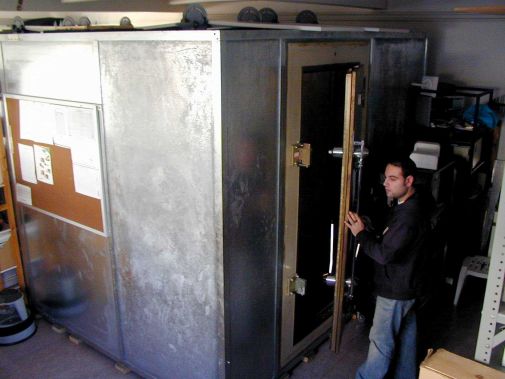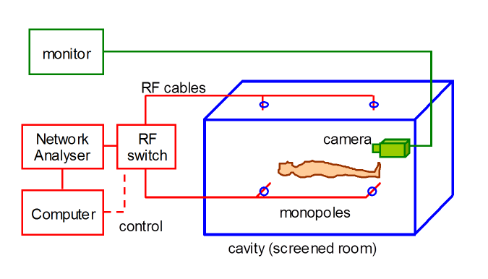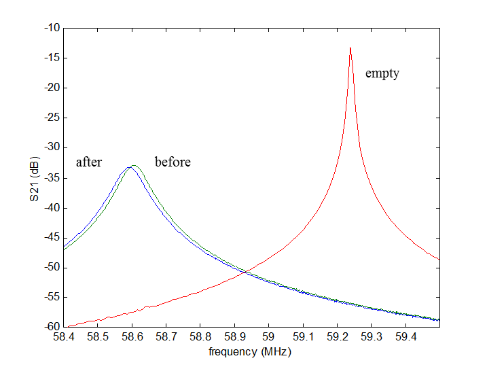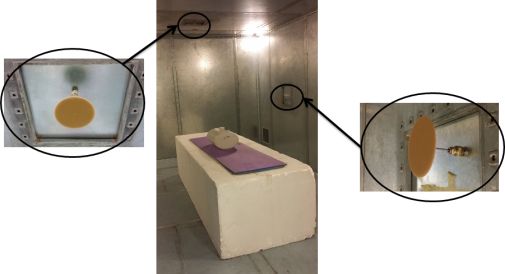Human Body Composition Measurements using Resonant Cavity Perturbation
Body composition studies, including measurement of total body water (TBW), have a wide range of medical applications. Changes in body hydration can be due to various conditions such as kidney failure, heart problems and obesity. However, the analysers currently used to measure TBW suffer from a lack of accuracy, while ‘gold standard’ dilution methods based on taking samples are too slow for routine clinical application.

Prototype of our RCP system being developed at York by PhD student Darren Stone
To improve this situation, we have developed a novel electromagnetic instrument for measuring body water, based on the resonant cavity perturbation (RCP) method. This involves the subject lying down inside a large, metal enclosure, adapted from the type of screened rooms that we use for our electromagnetic compatibility studies. Antennas on the walls and ceiling probe the low-order resonant frequencies of the room, and the changes to these, owing to the presence of the subject, give us information about the body’s dielectric properties. These in turn are strongly correlated to the subject’s TBW.

Principle of our RCP system
Our RCP instrumentation was initially developed in collaboration with John Truscott and colleagues at the Centre for Bone and Body Composition Research, Leeds General Infirmary. Validation studies against dilution techniques have shown that it gives accurate and repeatable results. Because the room is large, we avoid the claustrophobic effects associated with other medical scanners. The measurement takes only a few minutes, requires no electrodes to be attached to the subject, and uses safe, low levels of radiofrequency power. Our work was awarded the IET Wheatstone Measurement Prize for 2006.

Changes to the resonant frequency of the room can detect that the subject has imbibed some water
Funding sources have included the Royal Society Paul Instrument Fund and the White Rose Health Innovation Partnership. We have also investigated localised changes in hydration in limbs and joints, with applications in monitoring lymphoedema and arthritis. The RCP equipment is now based at Leeds Beckett University, where it is being used for nutritional studies of children, and in Sports Science to investigate hydration in elite athletes.

Inside of the RCP room, showing antennas and fluid-filled test object
Key publications
B. Oldroyd, M. P. Robinson, E. Lindley, L. Rhodes, K Hind 2015. ‘Resonant cavity perturbation: a promising new method for the assessment of total body water in children’ Physiol. Meas. 36 pp 2503-2517
M P Robinson, I D Flintoft, L Dawson, J Clegg, J G Truscott and X Zhu 2010, ‘Application of Resonant Cavity Perturbation to in-vivo Segmental Hydration Analysis’ Meas. Sci. Technol. 21 pp 015804.1-015804.10
D A Stone and M P Robinson 2004, ‘Total body water measurements using resonant cavity perturbation techniques’ Phys. Med. Biol. 49 1773-1788
M P Robinson, J Clegg and D A Stone 2003. ‘A novel method of studying total body water content using a resonant cavity: experiments and numerical simulation’ Phys. Med. Biol. 48 pp 113-125
